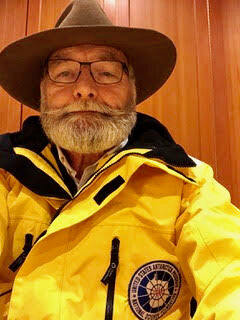Interview With A White Shark
Each fall, adult and sub-adult white sharks, Carcharodon carcharias, come to Greater Farallones National Marine Sanctuary to feed on seals and sea lions. Since the 1980s, researchers from Pt. Blue Conservation Science, the Monterey Bay Aquarium’s Tagging of Pacific Predators (TOPP) project and others have studied them, so agencies such as NOAA’s Greater Farallones National Marine Sanctuary and others can better protect these ecologically important apex predators.
Recently, a Farallones staffer interviewed one of the white sharks, Tom Johnson. The longest/best studied shark in the world, “TJ” is considered the Patriarch of Predators. He brought some interesting perspectives to the conversation.
MJ: Welcome, Tom. Why the name, “Tom Johnson”?
TJ: I had just bitten a seal at the Farallones, and a whale watch naturalist by that name snapped a quick shot of my dorsal fin. He donated the first photo in the researchers’ new Photo ID catalogue, hence the moniker. Kind of presumptuous, since we have our own names, but they’re helping us out here. I’m indebted. That was thirty-some years ago.
MJ: In addition to photo IDs, tagging helps researchers to study you. Were you fooled when researchers fed you a transmitter in a chunk of seal meat?
TJ: Hey, a meal is a meal, and a little extra roughage probably wouldn’t hurt.
MJ: We know that juvenile white sharks have started moving into your territory each spring, now that the ocean is warmer. Are they welcome?
TJ: Not really. Their music is atrocious, they don’t have the right moves or the right attitude. Their taste in food – it’s all over the place: fish-seals-fish-seals … so, decide already! But with experience they’ll learn that the best things in life – seals and such - can be found in better places than near shore. Go offshore, and go deep, Baby, go deep!
MJ: How do you feel about cage diving?
TJ: I’m all for cages. Some people belong in cages. They’re less likely to hurt anyone, in a cage. Let them out and next thing you know, they’re stabbing you and calling it self-defense.
MJ: Many surfers fear white sharks. Should they fear you here in our sanctuary?
TJ: Some of my best friends are surfers. Look: we share the ocean, and if I take a nip now and then, it’s to be expected. I’m a shark; it’s my nature. But I tell you: we really hate the taste of neoprene wetsuits, so it’s not intentional--not really.
MJ: How long have you been feeding in the Farallones marine sanctuary?
TJ: Well, it goes back much longer than the beginning of the research. It was when I got an appetite for meat. And by the way, we don’t call this place, “the Farallones,” we call this the White Shark Café, because dinner is always being served. Five stars.
MJ: But researchers call the mid-Pacific feeding area the White Shark Café, too. Can there be two?
TJ: Well, how many McDonalds are there in the world?
MJ: Do you have a food preference? Fat elephant seal pups, or leaner sea lions?
TJ: Seals. I want the fattest, juiciest meal I can find. Fat is where it’s at. Skinny sea lions, they’re good hors d’oeuvres, but you’re hungry an hour later.
MJ: What else do you do at the offshore White Shark Café? Do you mate?
TJ: Hey, that’s personal! But I will say, I always have a date Saturday nights. And the older females are the best company, in my experience.
MJ: Thank you, Tom, for taking time from your busy hunting schedule. Is there anything special you wish to say?
TJ: Mostly, just leave us alone. Take photos, attach little satellite tags, it’s okay; we can tolerate that. But watch it with the drift nets and the high speed boats. Don’t dump your garbage in my house. And turn the thermostat down! Clean up your act so the rest of us can enjoy the ocean, too.
Learn more about white sharks and sanctuary protections at www.farallones/noaa.gov. Also, Pt. Arena Lighthouse Peddler August 2019, “When White Sharks are the Catch of the Day.”
********
For more information on the sanctuary’s seabird research, education and resource protection, see https://farallones.noaa.gov/eco/seabird/, and https://farallones.noaa.gov/science/access.html









